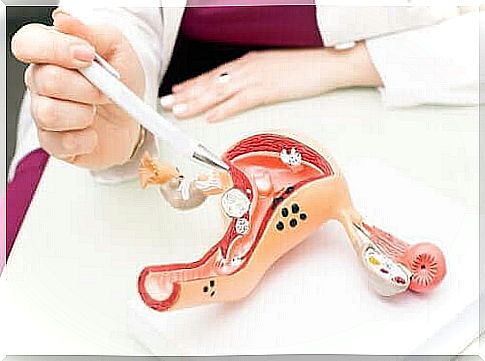Cervical Dysfunction: Symptoms And Complications

Cervical dysfunction is also known as a dysfunctional cervix. It occurs when the cervix dilates too early during pregnancy, usually without other symptoms. This leads to premature birth or miscarriage.
Normally, the cervix does not dilate until labor begins in response to contractions. But if cervical dysfunction occurs, this enlargement occurs during the second trimester of pregnancy without pain or contractions.
Cervical dysfunction is noticeable only when a woman is pregnant. Otherwise, her uterus looks normal. If a woman has had cervical dysfunction during a previous pregnancy, the same situation is likely to occur with other pregnancies.

Symptoms of cervical dysfunction
Some women experience minor bleeding during weeks 14-20 of pregnancy. Such bleeding can last for a few days or several weeks.
Some women also experience discomfort during the second trimester of pregnancy, below are a few examples:
- Changes in vaginal discharge
- Feeling of pressure in the pelvis
- Back pain that feels strange
- Mild abdominal cramps
What causes cervical dysfunction?
Science has not been able to determine any specific cause of cervical dysfunction. However, experts have been able to identify some factors that increase the risk of cervical dysfunction. The main ones are:
- More than one fetus in utero. Cervical insufficiency is more common in women who carry multiple babies at the same time.
- The person has had a cervical rupture in a previous birth.
- History of LEEP. This is a surgical electrosurgical procedure performed to prevent uterine cancer.
- Congenital connective tissue disorder. This includes several uterine abnormalities at birth, such as Ehlers-Danlos syndrome.
- Congenital defects of the uterus. These are present at birth and mean the uterus is abnormal.
- Cervical injury or trauma.
- Exposure to diethylstilbestrol. This is a hormonal drug. If a woman’s mother took this medicine while pregnant, it increases the risk of cervical insufficiency.
Women who have had multiple miscarriages, especially if they occurred before the fourth month of pregnancy, have a higher risk of cervical dysfunction.
Diagnosis of cervical dysfunction
Diagnosing cervical dysfunction is difficult, especially in the case of a first pregnancy. So, if a health care professional suspects this abnormality, he or she may prescribe some tests and procedures to confirm the diagnosis.
The usual diagnostic tests are as follows:
- Transvaginal ultrasound. This test measures the length of the cervix and determines if the membranes protrude through the cervix. If the cervix is less than 25 millimeters, it confirms cervical insufficiency.
- Pelvic examination. This is a visual and manual inspection to determine if the amniotic sac and fetal membranes are in place.
- Laboratory Analysis: Doctors perform tests when infection is suspected. To find out, they take a sample of amniotic fluid and analyze it under a microscope.
Cervical insufficiency: available treatments
Once the diagnosis of cervical insufficiency is confirmed, various therapies are available to avoid serious consequences. The goal of all of them is to delay childbirth for as long as possible. The available treatments are listed below.
Progesterone supplement
Studies carried out by several medical centers and universities in the Netherlands showed that a progesterone supplement would reduce the risk of preterm birth and miscarriage when a woman has a short cervix. Women can take progesterone as an injection or as a vaginal swab.
Cervical cerclage
Cervical cerclage is a surgical procedure in which the cervix is closed with strong sutures. This cerclage is removed between 36 and 38 weeks when it is safe to give birth. Pregnancy is considered to be full-term at week 37. Pregnancy is sometimes removed by doctors during childbirth.
Arabin’s pessary
This is a procedure where doctors wrap and close the cervix with a specially designed ring. In this case, surgery is not required. This technique is believed to be very effective when the mother has a V-shaped cervix. However, there is no research yet.
Bed rest
Bed rest has proven to be an effective method of delaying childbirth. Such sleep may be partial or complete. In some cases, the mother is only allowed to get up to eat and go to the bathroom. While this can be very inconvenient, it is a simple and proven method.

Risk factors and possible complications
In these cases, the most obvious risk factor is cervical trauma. If any injuries or surgeries have been performed in the area, the chance of cervical dysfunction increases.
As we have already stated, other risk factors include congenital problems, connective tissue diseases, and exposure to diethylstilbestrol. However, many women with this disease do not have known risk factors.
Experts have found that African American women are at a slightly higher risk for this problem. The most obvious and serious complications are premature birth or the possibility of miscarriage.
Regular prenatal screening is essential
There is no way to know if a woman has cervical dysfunction unless she is pregnant. This poses great difficulties in the early diagnosis and treatment of the disease.
It is best to maintain continuous and effective prenatal care. All symptoms, even if they do not appear to be severe, should be reported to your doctor.
It is also important to discuss any questions you may have with your doctor. In this way, the risk of complications is reduced.









